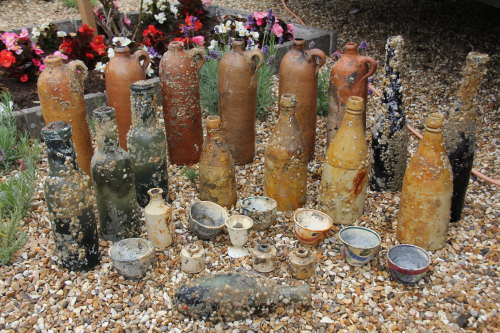
Image use policy
Our images can be used under a CC BY attribution licence (unless stated otherwise).
BOTTLE
Unique ID: MAS-D100072
Object type certainty: Certain
Workflow
status: Published ![]()
One Hamilton bottle also known as a torpedo or egg bottle. These bottles are named after their English inventor, William Francis Hamilton who took out a patent in 1809 for a method of bottling soda and other mineral waters, involving ovate bottles (although use of ovate bottle probably pre-dated his patent by at least 20 years). These bottles became common in the 1840s when the manufacturing of mineral water became very popular. Before this date, carbonated water was only sold on a small scale. The bottle was invented as a way of keeping the gas in fizzy drinks. The pointed base meant that the cork or stopper was always airtight as it was always wet and swollen due to being laid on its side (Dale 2012). A Swiss chemist, Jacob Schwepper, set up a chemist's shop in London and was selling the newly invited artificial fizzy spring water known as aerated water in the early years of the 19th century, and was an early user of the Hamilton bottles to keep in schweppervescence. However, bottles with a pointed base were difficult to transport and could not be stood upright (Dale 2012). Common use of ovate bottles runs from the 1830s through to the end of the century.
Notes:
This item was found with six stoneware seltzer bottles (MAS-D100065), four stoneware beverage bottles (MAS-D100066), two green glass wine bottles (MAS-D100068), 3 aqua glass bottles (MAS-D100071), four small stoneware ink bottles (MAS-D100074), six small bowls (MAS-D100076) and one egg cup (MAS-D100078).
All of these items were recovered from the wreck of SS Strathclyde, a British trading steamship built in 1871 in Blackwood, Port Glasgow. The ship sank in 1876 off Dover whilst carrying 23 passengers and 47 crew for Bombay, following a collision with Franconia and resulting in the loss of 38 lives.
NRHE and Kent HER reference numbers cited in this record refer to the wreck of SS Strathclyde.
The location of SS Strathclyde was taken from the British National Grid co-ordinate from the National Record of the Historic Environment.
Class:
Container
Sub class: Food and liquid storage container
Subsequent actions
Current location of find: With finder
Subsequent action after recording: Submitted as wreck to the Receiver of Wreck
Wreck details
Droit number: 173/17
Chronology
Broad period: NINETEENTH CENTURY
Period from: NINETEENTH CENTURY
Period to: NINETEENTH CENTURY
Dimensions and weight
Quantity: 1
Discovery dates
Date(s) of discovery: Monday 24th July 2017
Personal details
Found by: This information is restricted for your login.
Recorded by: L R
Identified by: L M
Secondary identifier: V L
Other reference numbers
NRHE monument number: 813607
Other reference: Kent HER Number: TR 33 NW 23
Droit ID: 173/17
Materials and construction
Spatial coordinates
4 Figure: TR3438
Four figure Latitude: 51.09353995
Four figure longitude: 1.34042371
1:25K map: TR3438
1:10K map: TR33NW
Display four figure position on What3Words
Unmasked grid reference accurate to a 1 metre square.
References cited
- Dale, R, 2012 DIGGING FOR TREASURE: A Guide to Finding Valuable Victorian Rubbish Dumps Indiana : Xlibris Book Publishing, ,
Similar objects

Find number: MAS-D100065
Object type: BOTTLE
Broadperiod: NINETEENTH CENTURY
Six stoneware seltzer bottles, of a type used to carry mineral water from various Continental (mainly German) spas. The term 'seltzer' takes i…
Workflow: Published![]()

Find number: MAS-D100074
Object type: INK BOTTLE
Broadperiod: NINETEENTH CENTURY
A collection of four ink bottles; one large and three small.
The larger stoneware ink bottle displays a pourer on the rim and is glazed with …
Workflow: Published![]()

Find number: MAS-D100066
Object type: BOTTLE
Broadperiod: NINETEENTH CENTURY
Four stoneware bottles (three large and one smaller) that were probably used for beer, ale, stout or porter.
Stoneware bottles provided the …
Workflow: Published![]()


